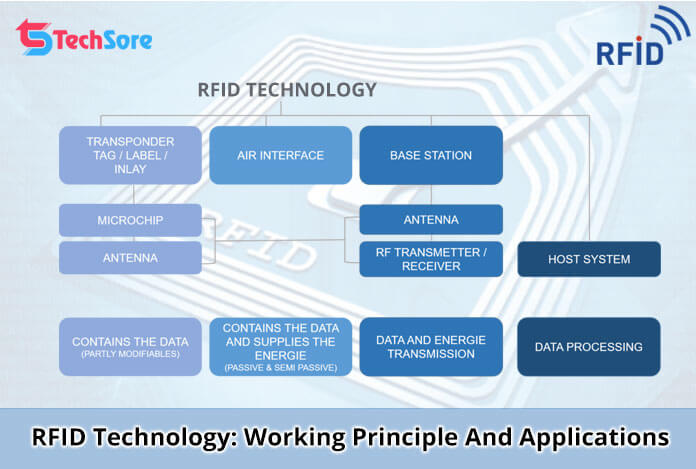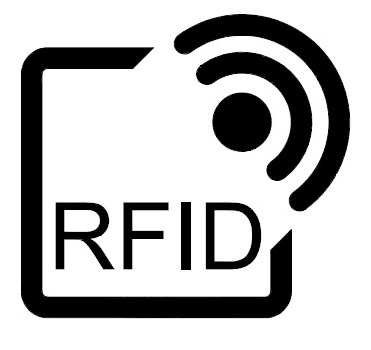
RFID Technology: Definition, Working Principle And Applications
“RFID technology- Ultimate change in the tracking and managing of objects”. A definition of RFID technology is not enough to describe its application.
When we hold a large variety with the huge number it becomes difficult to keep the record manually of everything. At this stage, we need automatic identification to deal with such issues.
RFID Technology is deal perfectly with tracking and managing objects. Its applications are very convincing while managing anything like Books, tools, appliances etc. Let’s see what exactly RFID is!
Table Of Content-
- Definition of RFID Technology
- RFID Technology v/s Barcode
- RFID Chip uses
- Smart Labels
- RFID Frequency
- How RFID Works
- RFID Uses
- Future Uses Of RFID Technology
- RFID USES In Business
1. Definition of RFID Technology

RFID stands for Radio-Frequency Identification. It uses an electromagnetic field for automatic identification. RFID belongs to a technology, that encodes the digital data in RFID tags which is read by a reader through radio waves.
The concept is similar to barcoding but the technique is different. The scanning of a barcode is done by a device that stored data in a database. However, RFID has diversity over devices that use barcode asset tracking software.
Let’s go through the difference between RFID and Barcode-
2. RFID Technology v/s Barcode
The basic difference is, RFID is much more around the automatic process whereas barcode is revolved around the accuracy and efficiency of product in the warehouse.
RFID reads the EPC(Electronic Product Code) via radio signals from the RFID tag with an RF reader automatically. While barcodes need an optical reader or scanner. The scanner decodes the barcode which is a combination of numbers and sends.
Furthermore, RFID tags are implanted in animals an humans too. Which is not possible in with the barcodes.
RFID works efficiently across visually and in different circumstances such as human body, paint, smoke, fog, snow ice etc. whereas optically read technology such barcode doesn’t work.
Another difference is, RFID is read it tags from far apart but in barcode, the device needs appropriate distance to read the barcode.
Moving on, RFID is a better technology on barcodes to track and manage products. Previously, we talk about RFID tags. Let’s see what is it!
3. RFID Chip uses
The RFID tag is also known as RFID chip. Radio Frequency Identification tags are an Electronic tag that exchanges that transfers data to an RFID reader through radio waves.
Most of the tags are created with at least two parts. One is an Antenna, that receives RF(Radio frequency) waves. Another one is IC(Integrated circuit), that process and stores the data. It also modulates and demodulates the radio waves received by the antenna.
The RFID chip is made up of material to grab the pieces together and protect them from various environmental conditions. The selection of material used to shields the chip depends on the application. Like durable plastic is used for employee ID badges.
The tags are available in different shape and size & active. They are either in passive or active forms. Passive tags are mostly used tags. They are smaller and less expensive to implement. Passive tags are powered by the RFID reader before they exchange data.
However, active RFID tags have an onboard power supply, for example, a battery. That enables them to exchange all the time.
Another thing which includes in both barcodes and RFID is ‘Smart labels’
Smart Labels in RFID
Smart labels incorporated both RFID and barcode technologies. Ther are made up of an adhesive label that contains RFID tags and may feature a barcode and/or other printed information.
These labels are created and printed on demand using a desktop, label printers. Smart labels consume less time. However, RFID programming takes more time as it requires advanced equipment.
Now we move on to RFID frequency.
RFID Frequency
As the radio is tune for certain frequencies. Similarly, RFID frequency is also tune by the tags and readers in order to communicate. There are a variety of frequencies use in the RFID system the most common frequency range are-
- LF(Low Frequency)-125-134lHz
- HF(High Frequency)-13.56kHZ
- UHF(Ultra-high frequency)-433,and 860-960MHz
Each range of frequency have their own significance like low-frequency tags has a long wavelength. This makes it able to penetrate in thin metallic substances. That’s why low-Frequency RFID systems are use for objects with high- water content like fruits, beverages, etc.. But the range limit is centimeter or inches.
Moreover, high-frequency work with metal objects and also can work around moderate to high water content. High-frequency RFID system work in ranges of inches which maximum reaches to 1 meter.
UHF frequency has a better read range from inches to 50+ ft. and also the exchange of data is faster than LF and HF. However, UHF has a shorter wavelength that’s why its signals are weaker. So, UHF frequencies cannot pass through metal and water. UHF RFID tags are suits well for the boxes for racers etc.
Let’s see how RFID works-
How RFID Works
Basically, RFID technology relates to the techniques that connect to Automatic Identification and Data Capture(AIDC).
AIDC orders automatically recognize objects, gather data about them, and record those data straight into computer systems with or without human intervention.
As discussed before the RFID technology system consists of three component- RFID tags consist of code or smart labels, RFID readers, and an antenna. RFID tags contain an IC and an antenna. The antenna transmits the data to the reader. Then the reader converts the radio waves to a readable form of Data.
After this, the information gathers from the RFID tags is transfer in a host computer system through a communication interface. The host computer system stores all the data and analyzes it later.
Now, comes the RFID uses-
RFID Uses
No doubt Frequency identification devices have great applications and have a bright future in the tech industry. Talking about RFID uses, these technologies apply in many industries for different purposes. See the examples of RFID technology uses-
- Asset tracking- One of the best application of RFID technology. Tracking or locating static assets. For Example healthcare accessories(wheelchair), IT asset tracking(like laptops, tabs, mobiles etc.) corporation and server in a data center.
- People tracking- Generally done in hospital and jail. It uses RTLS (Real Time Location System) to tracks special patient and criminals from the RFID chip. Such uses of RFID technology makes the place more safe of the people living in society.
- Document tracking- Used in industries and publication to find out the documents from the bunch.
- Employee ID Badging- Track employees with the help of Badge. This application of RFID technology brings more discipline in workplaces.
- Inventory management- For warehouse purposes to track and manage products present in the warehouse.
- Supply chain Prevention.
- Running sale counter prevention- For Retail shop counter management. This application of RFID technology makes the billing fast an accurate
- Access control to restricted areas- Used in certain areas of house and professional places which need high-level of security and access from doors to parking lots.
- Library systems- Manage books and helps to smoothly run the library. Laundry Management- Large companies like casino manages employee uniforms with an RFID laundry management system.
RFID has vast application to use. Also, it can be modified as per requirement and this still in progress.
Future Uses Of RFID Technology
The adoption of the RFID technology from the last decades in the market is really exclusive. A report from research and market says, that the global sourcing of RFID tags has a growth of 22.4% RFID throughout 2018. And it’s a prediction that it will label market at $10 billion by 2020.
The future uses of RFID technologies will increase because of the innovation going in its features and equipment. Let’s see the Future innovation going in RFID-
- As the advancement of printed electronic is going, it helps is creating thin and flexible RFID chips. These thin and flexible tags are can combine with printed sensors, batteries, thin film photovoltaic solar cells, and other advanced technologies.
- Latest antenna devices will improve the range because it increases the accuracy of determining where and how RFID chip can be used.
- The future idea of RFID tech is to increase memory to create smart tags.
- Adnavce sensor integration in businesses and industries to manage assets and monitor them.
- The latest approach of RFID technologies is to secure your data with new cloud base capabilities.
RFID Uses In Business
Business is the setup of so many works and technologies together. And it takes so much effort to manage everything. RFID application can help in many ways. Let’s have a look at how RFID uses in business-
- RFID increase the efficiency of your business Because it requires less monitoring as compared to barcode and scanning makes your business efficient. Because RFID can read multiple tags in type.
- RFID application reduces human errors. Because the setup is automatic.
- RFID give you accurate and real-time data which is very important for a business.
- Because of Realtime monitoring RFID give you accurate data for analysis which helps you to make important decision for your business.
Conclusion:
Everything which you track helps in managing. RFID is an ongoing technology. It has a discriminant variety of application and a new way to improve security in both a personal and professional level.
RFID is also use in credit and debit cards but due to security and handling issue, it still not reaches a better level.
Hope you like the article, Keep sharing the information with others also maybe they need RFID technology in their house or office.





1 thought on “RFID Technology: Definition, Working Principle And Applications”